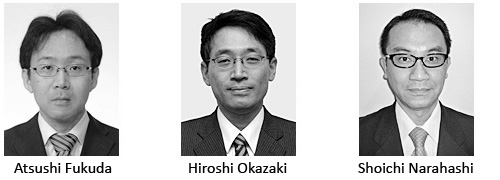| A leading study on the multi-band operation of power amplifiers for mobile terminals |
| Atsushi Fukuda, Hiroshi Okazaki, Shoichi Narahashi |

@Since 2003, the awardees have investigated a circuit configuration for the multi-band operation of power amplifiers (PAs) which are key components in RF circuits for mobile terminals. The point of the awardeesf approach is to employ variable devices for tuning the frequency characteristics of matching networks of a PA. The awardees invented a concise configuration using switches as variable devices because the use of variable capacitors with a PIN diode is considered to be disadvantageous from the standpoint of power consumption and nonlinear distortion generation by the high-power operation of variable capacitors.
@ The awardeesf approach is based on a single-stub matching scheme and has the advantage of flexibility in the frequency band design: an operating band can be easily expanded by simply adding one matching block to a transmission line via a single-pole single-throw switch. In 2010, the awardees presented a three-stage, single-path-type, multi-band PA operating in nine bands from 0.7 to 2.5 GHz with a gain of over 30 dB. It also achieved an output power greater than 34 dBm and a power added efficiency of over 40% at a supply voltage of 3.5 V in each operating band. This was the first report in the world to demonstrate that a single-path-type PA can provide comparable performance to a single-band PA in each frequency band from 0.7 to 2.5 GHz. In 2011, the awardees proposed a compact PA with the size of 6 mm by 8 mm to verify the possibility of further downsizing the PA for practical use.
@ Since their report on the dual-band PA in 2004, the awardees have had their research results recognized by researchers and engineers in the field of not only RF circuits but also software defined radios, cognitive radios, and switch devices, which affords them many opportunities for invited talks on the multi-band PA for mobile terminals at international conferences. The awardeesf approach and research activities have led to research and development of the multi-band operation of RF circuits for mobile communications, which has a significant effect on researchers and engineers in broad fields such as communication systems and devices. Thus, the awardeesf remarkable achievements are eligible for the Achievement Award.
[2]A. Fukuda, H. Okazaki, and S. Narahashi, gHighly Efficient Multi-Band Power Amplifier Employing Reconfigurable Matching and Biasing Networksh, IEICE Trans. Electron., E93-C, 7, pp.949-957 (2010-07)
[3]A. Fukuda, K. Kawai, T. Furuta, H. Okazaki, S. Oka, S. Narahashi, and A. Murase, gA High Power and Highly Efficient Multi-Band Power Amplifier for Mobile Terminals,h Proc. IEEE Radio and Wireless Symposium 2010, pp.45-48, Jan. 2010.
[4] T. Furuta, A. Fukuda, K. Kawai, H. Okazaki, and S. Narahashi, gCompact 1.5 GHz to 2.5 GHz Multi-Band Multi-Mode Power Amplifierh, IEICE Electronics Express, 8, 11, pp.854-858 (2011)
[5]A. Fukuda, T. Furuta, H. Okazaki, S. Narahashi, and T. Nojima, gLow-loss Matching Network Design for Band-Switchable Multi-Band Power Amplifier,h Accepted for publication in IEICE Trans. Electron., E95-C (2012-07)

Figure 1 Basic configuration of multi-band power amplifier

Figure 2 Compact multi-band power amplifier